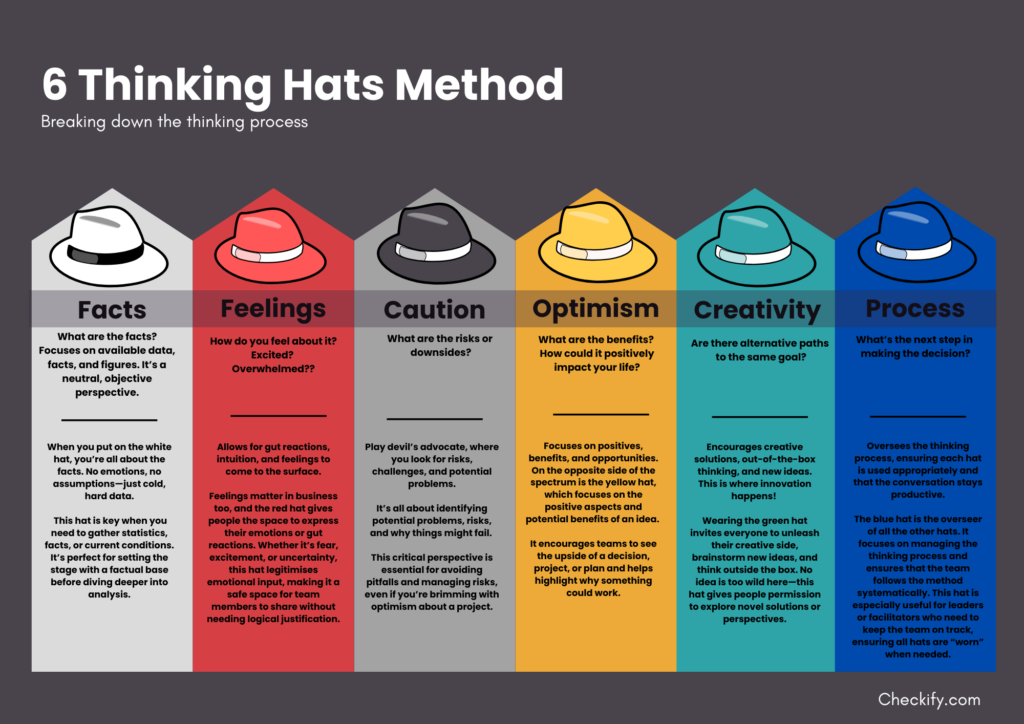
Making quick yet informed decisions can make or break a project. Imagine being able to think from every angle, swiftly evaluating a problem or opportunity from multiple perspectives. Sounds like a superpower, right? That’s where the Six Thinking Hats method swoops in, saving the day for business teams everywhere!
Developed by Edward de Bono, this simple yet powerful tool is designed to streamline decision-making and improve creativity, promoting diverse thinking perspectives, improving communication, and help problem-solving.
Whether you’re in the boardroom, managing a project, or making personal decisions, this approach can help you navigate complex challenges in a more efficient and thoughtful way. But how does it work, and why should you think about using it in your business?
Let’s put on our metaphorical hats and dive into how you can integrate this methodology into your process management toolkit.
Who is Edward de Bono?
Edward de Bono was a Maltese physician, psychologist, and author widely recognised for his creative thinking and problem-solving work. Born in 1933, he is best known for pioneering the concept of lateral thinking, a method of approaching problems in innovative, indirect ways. Throughout his career, De Bono wrote over 80 books on thinking techniques, including the famous Six Thinking Hats and Lateral Thinking. His methods have been used by businesses, governments, and educational institutions around the world to foster creativity, collaboration, and effective decision-making.
What is Six Thinking Hats?
The Six Thinking Hats is a problem-solving and decision-making technique that helps individuals and teams think more effectively by focusing on different perspectives. Each of the six “hats” represents a distinct mode of thinking—such as facts, emotions, creativity, or critical judgment—allowing participants to approach issues systematically. By “wearing” one hat at a time, people and teams can explore all aspects of a problem or idea, leading to well-rounded, informed decisions. It’s a simple yet powerful tool for improving communication, opening discussions, and adding clarity to decisions in business and beyond.
Six Thinking Hats Method
The Six Thinking Hats method is designed to encourage thinking from multiple perspectives by breaking down the thinking process into six distinct modes, each represented by a different coloured hat. By “wearing” these hats, these hats aren’t literal (thankfully!), but symbolic of different thinking modes; teams or individuals can systematically approach problems from various perspectives. It’s like giving your brain six different operating systems to use one at a time. Here’s how it breaks down:
- White Hat – Facts and Information:
Focuses on available data, facts, and figures. It’s a neutral, objective perspective.
When you put on the white hat, you’re all about the facts. No emotions, no assumptions—just cold, hard data. This hat is key when you need to gather statistics, facts, or current conditions. It’s perfect for setting the stage with a factual base before diving deeper into analysis. - Red Hat – Feelings and Emotions:
Allows for gut reactions, intuition, and feelings to come to the surface.
Feelings matter in business, too, and the red hat gives people the space to express their emotions or gut reactions. Whether it’s fear, excitement, or uncertainty, this hat legitimises emotional input, making it safe for team members to share without needing logical justification. - Black Hat – Causion and Critical Judgment:
Play devil’s advocate, where you look for risks, challenges, and potential problems.
It’s all about identifying potential problems, risks, and why things might fail. This critical perspective is essential for avoiding pitfalls and managing risks, even if you’re brimming with optimism about a project. - Yellow Hat – Optimism:
Focuses on positives, benefits, and opportunities.
On the opposite side of the spectrum is the yellow hat, which focuses on the positive aspects and potential benefits of an idea. It encourages teams to see the upside of a decision, project, or plan and helps highlight why something could work. - Green Hat – Creativity:
Encourages creative solutions, out-of-the-box thinking, and new ideas.
This is where innovation happens! Wearing the green hat invites everyone to unleash their creative side, brainstorm new ideas, and think outside the box. No idea is too wild here—this hat gives people permission to explore novel solutions or perspectives. - Blue Hat – Process Control:
Oversees the thinking process, ensuring each hat is used appropriately and that the conversation stays productive.
The blue hat oversees all the other hats. It focuses on managing the thinking process and ensuring that the team follows the method systematically. This hat is especially useful for leaders or facilitators who need to keep the team on track and ensure that all hats are “worn” when needed.
6 Thinking Hats Method Diagram

Why Should Businesses Use the Six Thinking Hats?
Great question! The Six Thinking Hats method offers a structured, flexible approach to problem-solving that benefits every type of business. Here are a few reasons why your team should embrace it:
Improved Decision-Making: With this method, you’re not just diving headfirst into a decision. Each hat ensures that you consider every aspect—logical, emotional, optimistic, critical—before making a call. This holistic approach leads to more informed, well-rounded decisions.
Encourages Diverse Perspectives: The Six Thinking Hats give everyone permission to think in ways they might not normally feel comfortable. Often, team members shy away from criticism or emotional input, but with this method, all types of thinking are invited, even required. It’s a way to unlock every individual’s unique contribution.
Prevents Groupthink: Groupthink, where teams make decisions based on conformity rather than critical analysis, is a common pitfall in business. The Six Thinking Hats directly counteract this by encouraging each team member to explore ideas from every angle, including potential risks and benefits.
Streamlines Process Management: The structured nature of this method makes it a natural fit for process management. By dividing the thinking process into distinct “hats,” your team can systematically tackle problems, ensuring no stone is left unturned and that the process runs smoothly from start to finish.
Boosts Creativity: Too often, creativity gets lost in business settings. The green hat, in particular, encourages out-of-the-box thinking, making it a perfect tool for innovation-driven companies or for projects requiring fresh ideas.
How Can We Use Six Thinking Hats in Process Management?
Process management is all about finding ways to streamline operations, improve efficiency, and optimize workflows. The Six Thinking Hats can be particularly useful here:
- Analysing Current Processes: Use the White Hat to assess data on current performance, the Black Hat to critique inefficiencies, and the Green Hat to suggest improvements.
- Improving Communication: By assigning hats during meetings, team members learn to express their thoughts in a more structured, less emotional manner, making discussions more efficient and productive.
- Risk Management: The Black Hat is especially powerful in process management, where identifying potential risks and bottlenecks is critical. Meanwhile, the Yellow Hat helps you see opportunities to enhance processes.
- Continuous Improvement: With the Green Hat, you can foster a culture of innovation where team members regularly propose creative improvements to the process.
Using the Six Thinking Hats in Process Management
Okay, now we know the hats, but how can you use them as part of a larger process management framework? Here’s how:
Define the Problem with the White Hat
Start by clearly defining the issue or decision at hand using facts only. In a process management setting, this might include reviewing KPIs, project deadlines, or resource allocation.
Evaluate Risks with the Black Hat
Before rushing in, use the black hat to identify risks or challenges. This is where you think about potential delays, budget overruns, or stakeholder concerns. It’s a crucial step to anticipate and plan for obstacles in any business process.
Explore Opportunities with the Yellow Hat
Now switch to a more optimistic lens. Use the yellow hat to identify potential benefits or efficiencies in the process. This could mean finding faster ways to complete tasks or improving customer satisfaction through process adjustments.
Get Creative with the Green Hat
Unleash creativity to think of innovative solutions to streamline your process. This might involve integrating new technologies, reassigning team responsibilities, or rethinking workflow design.
Check the Emotional Pulse with the Red Hat
Bring in the emotional aspect: how do team members feel about the process changes? Are there concerns about workload or morale? Listening to this input helps ensure buy-in and can often highlight unspoken issues.
Wrap Up with the Blue Hat
Finally, as the blue hat wearer, ensure all the steps are completed. Summarise the findings, develop an action plan, and confirm that everyone is aligned. The blue hat ensures that the process remains on track and leads to actionable outcomes.
Six Thinking Hats
The Six Thinking Hats method is more than just a clever, fun way to approach problems; it’s a structured thinking, decision maing tool that can revolutionise how your business manages processes, makes decisions, and innovates. By encouraging diverse perspectives, you reduce groupthink, improve problem-solving, and make well-rounded decisions. Whether you’re in a team meeting, planning a new project, or improving an existing process, the Six Thinking Hats method can guide you to better outcomes—one hat at a time.
So, ready to try on a hat?